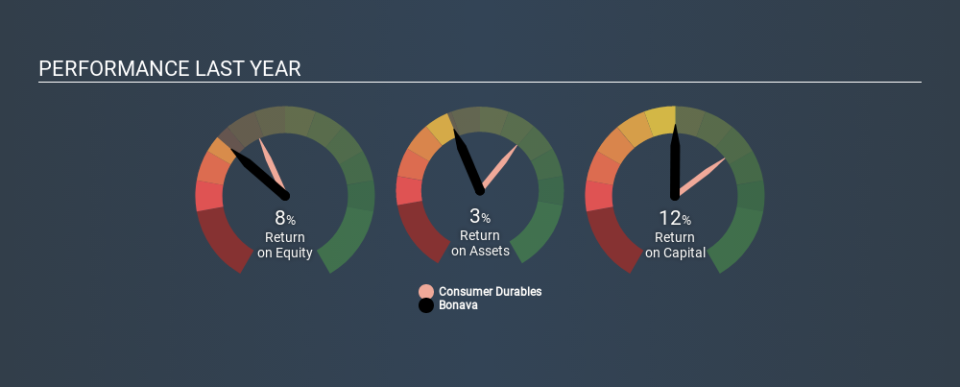Does Bonava AB (publ)’s (STO:BONAV B) ROCE Reflect Well On The Business?

Today we'll evaluate Bonava AB (publ) (STO:BONAV B) to determine whether it could have potential as an investment idea. Specifically, we're going to calculate its Return On Capital Employed (ROCE), in the hopes of getting some insight into the business.
First of all, we'll work out how to calculate ROCE. Second, we'll look at its ROCE compared to similar companies. Last but not least, we'll look at what impact its current liabilities have on its ROCE.
What is Return On Capital Employed (ROCE)?
ROCE measures the 'return' (pre-tax profit) a company generates from capital employed in its business. Generally speaking a higher ROCE is better. In brief, it is a useful tool, but it is not without drawbacks. Renowned investment researcher Michael Mauboussin has suggested that a high ROCE can indicate that 'one dollar invested in the company generates value of more than one dollar'.
How Do You Calculate Return On Capital Employed?
The formula for calculating the return on capital employed is:
Return on Capital Employed = Earnings Before Interest and Tax (EBIT) ÷ (Total Assets - Current Liabilities)
Or for Bonava:
0.12 = kr1.2b ÷ (kr23b - kr14b) (Based on the trailing twelve months to December 2019.)
Therefore, Bonava has an ROCE of 12%.
Check out our latest analysis for Bonava
Does Bonava Have A Good ROCE?
ROCE is commonly used for comparing the performance of similar businesses. We can see Bonava's ROCE is around the 10% average reported by the Consumer Durables industry. Regardless of where Bonava sits next to its industry, its ROCE in absolute terms appears satisfactory, and this company could be worth a closer look.
Bonava's current ROCE of 12% is lower than its ROCE in the past, which was 18%, 3 years ago. Therefore we wonder if the company is facing new headwinds. You can see in the image below how Bonava's ROCE compares to its industry. Click to see more on past growth.
When considering this metric, keep in mind that it is backwards looking, and not necessarily predictive. Companies in cyclical industries can be difficult to understand using ROCE, as returns typically look high during boom times, and low during busts. ROCE is, after all, simply a snap shot of a single year. What happens in the future is pretty important for investors, so we have prepared a free report on analyst forecasts for Bonava.
How Bonava's Current Liabilities Impact Its ROCE
Short term (or current) liabilities, are things like supplier invoices, overdrafts, or tax bills that need to be paid within 12 months. Due to the way the ROCE equation works, having large bills due in the near term can make it look as though a company has less capital employed, and thus a higher ROCE than usual. To check the impact of this, we calculate if a company has high current liabilities relative to its total assets.
Bonava has current liabilities of kr14b and total assets of kr23b. Therefore its current liabilities are equivalent to approximately 58% of its total assets. Bonava has a relatively high level of current liabilities, boosting its ROCE meaningfully.
Our Take On Bonava's ROCE
While its ROCE looks decent, it wouldn't look so good if it reduced current liabilities. There might be better investments than Bonava out there, but you will have to work hard to find them . These promising businesses with rapidly growing earnings might be right up your alley.
Bonava is not the only stock insiders are buying. So take a peek at this free list of growing companies with insider buying.
If you spot an error that warrants correction, please contact the editor at editorial-team@simplywallst.com. This article by Simply Wall St is general in nature. It does not constitute a recommendation to buy or sell any stock, and does not take account of your objectives, or your financial situation. Simply Wall St has no position in the stocks mentioned.
We aim to bring you long-term focused research analysis driven by fundamental data. Note that our analysis may not factor in the latest price-sensitive company announcements or qualitative material. Thank you for reading.



